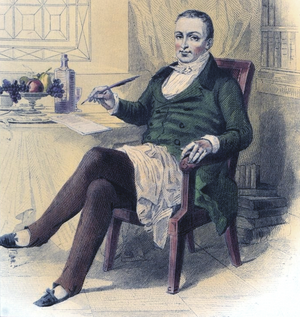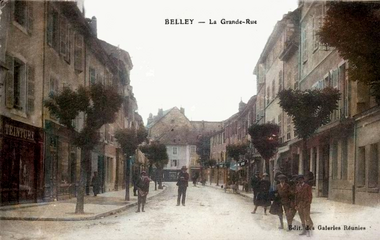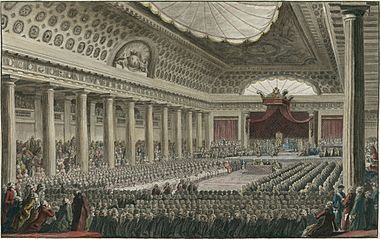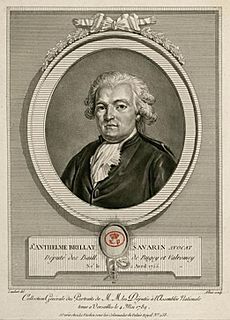Jean Anthelme Brillat-Savarin facts for kids
Quick facts for kids
Jean Anthelme Brillat-Savarin
|
|
|---|---|

Posthumous portrait, 1848
|
|
| Born | 2 April 1755 Belley, France |
| Died | 2 February 1826 (aged 70) Paris, France |
| Resting place | Père Lachaise Cemetery |
| Notable works | Physiologie du goût (The Physiology of Taste) |
"Tell me what you eat, and I will tell you what you are."
Jean Anthelme Brillat-Savarin (born April 2, 1755 – died February 2, 1826) was a famous French lawyer and politician. He became well-known for his book Physiologie du goût (The Physiology of Taste). This book shared his thoughts and memories about cooking and the joy of eating.
Brillat-Savarin became quite important in France during the old government. But when the Reign of Terror began in 1793, he had to leave the country. He lived in the United States for almost three years. To earn money, he taught French and played the violin. When it was safe, he returned to France. He continued his law career and rose to become a top judge.
The Physiology of Taste was a project he worked on for many years in his free time. It was published just weeks before he passed away in 1826. This book made him famous as one of the first writers of "gastronomic essays." These are essays that explore the art and science of food.
Contents
Life and Career of Brillat-Savarin
His Early Life and Education

Jean Anthelme Brillat-Savarin was born on April 2, 1755. His hometown was Belley, a small city in France. It was about 80 kilometers (50 miles) east of Lyon.
His family on both sides were lawyers. His father, Marc-Anthelme Brillat-Savarin, was a leading lawyer in Belley. His mother, Claudine-Aurore Récamier, was the daughter of a Royal Notary. Jean Anthelme was the oldest of eight children.
Good food was very important in his family and region. A relative, Lucien Tendret, wrote about the amazing variety of food there. He mentioned delicious beef, tasty lamb, famous hams, and good sausages. There were also plump chickens, ducks, crayfish, trout, and pike. Truffles and mushrooms were also plentiful.
Brillat-Savarin learned many special things about food from his parents' friends. He learned a three-day way to cook spinach. He also learned how to eat small game birds and prepare chocolate drinks. His school education was more traditional. He went to the Collège de Belley. It was a religious school but also taught about agriculture and science. As a schoolboy, he started playing the violin. He loved it and even thought about becoming a professional violinist.
In 1774, Brillat-Savarin went to the University of Burgundy. He mainly studied law. But he also took extra classes in medicine and chemistry. He became friends with his chemistry teacher, Louis-Bernard Guyton de Morveau.
His Role in French Politics
After finishing university in 1778, Brillat-Savarin became a lawyer in Belley. He quickly became successful. In 1781, he was made a judge in the local civil court. As he became more important, he tried to help the poor people in his area. They were suffering from money problems and bad harvests.
In 1788, there were protests in France. The king, Louis XVI, had to call a meeting of the Estates General. This was a national assembly that hadn't met since 1614. It usually only met when the king had no other choice.
When the king called the Estates General in 1789, Brillat-Savarin was chosen to represent his hometown. He was not a revolutionary. When the Estates General became the National Constituent Assembly, he spoke against some big changes. These included dividing France into new departments and ending the death penalty.
In 1791, Brillat-Savarin returned home as president of the court in his new department. But the politics in Paris became very extreme. The monarchy was ended. Brillat-Savarin was seen as someone who supported the king. He was removed from his job. However, he was very popular. In December 1792, he was elected mayor of Belley. For almost a year, he tried to protect his city from the harsh changes of the revolution.
When the Reign of Terror began in September 1793, he felt he was in danger. On December 10 or 11, he fled France to Switzerland. He stayed with relatives there. He learned his famous recipe for fondue from them. He was joined by another person who had to leave France, Jean-Antoine de Rostaing. Rostaing suggested they go to the United States. Brillat-Savarin agreed. They traveled to Rotterdam and took a ship to Manhattan. They arrived on September 30, 1794.
His Time in America
Brillat-Savarin stayed in the US for almost two years. He supported himself by teaching French and violin lessons. He even called himself "Professor." He also played first violin in America's only professional orchestra at the John Street Theatre in New York.
He had good memories of his time in America. He said he was happy because he spoke their language, dressed like them, and praised their ways. He felt this helped him repay their hospitality.
While visiting a friend in Hartford, Connecticut, he shot a wild turkey. He cooked it and wrote that it was "charming to behold, pleasing to smell, and delicious to taste."
Returning to France
Rostaing returned to France in May 1795. Brillat-Savarin missed his friend. He also wanted to return to France, partly because he was running out of money. He sailed home and arrived in August 1796. By then, the extreme political period in France was over. Robespierre and his allies were gone. France was now ruled by a more moderate government called the Directory. Brillat-Savarin convinced the authorities to let him return without punishment.
With Rostaing's help, Brillat-Savarin was appointed as a secretary to General Charles-Pierre Augereau. The general was leading the French army fighting on the Rhine river. Brillat-Savarin was put in charge of providing food for the general staff. He did this so well that his fellow officers were very happy.
After the Rhine campaign, he became President of the Criminal Court in 1798. Then he became a State Prosecutor. In 1799, after Napoleon Bonaparte took power, Brillat-Savarin was appointed as a judge in the Tribunal de cassation. This was the highest court of appeal in Paris. He received the Legion of Honour in 1804. In 1808, Napoleon made him a knight.
His Later Years
For the rest of his life, Brillat-Savarin lived a happy life. He did his judge duties carefully, entertained friends, and wrote. He never married. Playing the violin remained a favorite hobby. He could now afford a Stradivarius violin. He played for his friends, though never professionally again.
His dinners at his house in Paris became famous for their excellence. His beautiful cousin, Juliette Récamier, often attended these dinners. She asked him for advice. It is thought that he may have been in love with her. He wrote a special dedication to her in the copy of his book he sent her before he died.
For many years, Brillat-Savarin worked on his book Physiologie du goût. He kept adding, changing, and improving it. His friends knew about its contents and urged him to publish it. He published it anonymously in December 1825, just two months before he died. However, his name soon became widely known.
Brillat-Savarin died on February 2, 1826, at the age of seventy. He had caught a cold that turned into pneumonia. He was buried at the Père Lachaise Cemetery in Paris.
His Famous Book: Physiologie du goût
The full title of Brillat-Savarin's most famous book is Physiologie du goût, ou méditations de gastronomie transcendante; ouvrage théorique, historique et à l'ordre du jour, dédié aux gastronomes parisiens, par un professeur, membre de plusieurs sociétés littéraires et savantes. This means "The Physiology of Taste, or Meditations on Transcendental Gastronomy; a theoretical, historical, and up-to-date work, dedicated to Parisian gastronomes, by a professor, member of several literary and learned societies."
The book has been printed continuously in France since 1825. It has also been translated into many languages. The first English version came out in the US in 1854. Many other translations followed, often with new titles like The Handbook of Dining or Gastronomy as a Fine Art.
The book has two main parts. It starts with "Aphorisms," which are twenty short statements about food. For example, one says: "Animals feed: man eats: only the man of intellect knows how to eat." Another says: "The pleasures of the table belong to all times and all ages... they go hand in hand with all our other pleasures."
The longest part is "Gastronomical Meditations." Here, Brillat-Savarin writes short chapters on thirty topics. These include taste, appetite, thirst, and digestion. He also writes about gourmands (people who love food), obesity, and restaurants. The second part is "Miscellanea." This includes many fun stories about food and memories from his time in exile.
Things Named After Him
The soft Brillat-Savarin cheese was named in his honor. A cheese-maker named Henri Androuët named it in the 1930s.
He is also remembered in a dish called Bordure de pommes Brillat-Savarin. This is a cake soaked in syrup and rum, surrounded by stewed apples. The cake itself, called a savarin, was a new version of a rum baba. It was first called a Brillat-Savarin, then shortened to savarin.
In 1926, special dinners were held to mark 100 years since his death. These banquets took place in Paris and London. The dishes included "Les delices de Belley" (a mix of foie gras and crayfish) and "Les œufs brouilles Brillat-Savarin" (scrambled eggs with truffles). These dishes honored his name and birthplace.
Many streets in France and Belgium are named after him. These include avenues and streets in cities like Brussels, Belley, Paris, and Dijon.
His Ideas and Influence
Brillat-Savarin, along with Grimod de La Reynière, is known for starting the "gastronomic essay" style of writing.
He was also an early supporter of a low-carbohydrate diet. He believed that sugar and white flour caused people to gain weight. Instead, he suggested eating foods rich in protein.
He wrote: "Carnivorous animals never grow fat (think of wolves, birds of prey, crows). Animals that eat plants don't get fat easily, unless they become inactive. But they get fat very quickly if they eat potatoes, grain, or any kind of flour... The second main cause of obesity is the floury and starchy foods that humans eat a lot of. As we've said, all animals that live on starchy food get fat, and humans are no different."
He suggested a diet that avoided starch, grains, sugar, and flour. He recommended eating meats, root vegetables, cabbage, and fruit.
Images for kids
-
Le Grande Rue, Belley, Brillat-Savarin's birthplace (around 1900)
See also
 In Spanish: Jean Anthelme Brillat-Savarin para niños
In Spanish: Jean Anthelme Brillat-Savarin para niños















